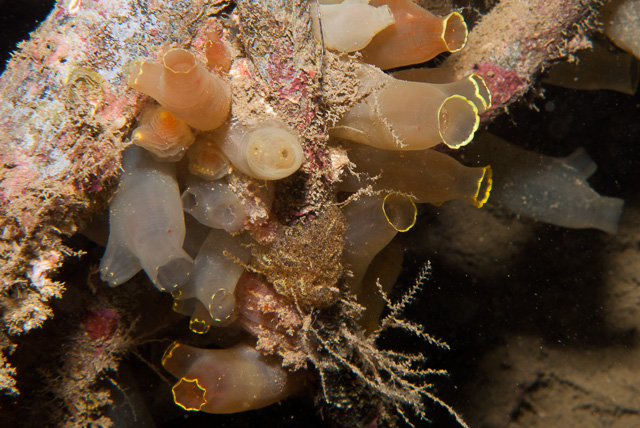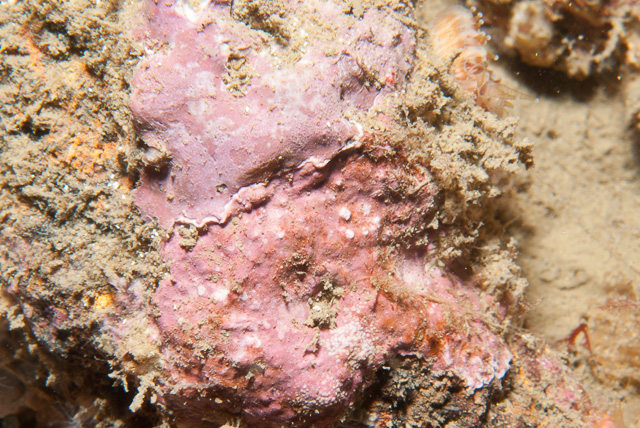SeaSearch Karlsruhe
November 25th 2012 and Team Seasearch (whiteboard pic) set out to look at the Karlsruhe with fresh eyes. Divers have been exploring the wreck of the Karlsruhe as a mechanical sunken ship for years and along the way, many have enjoyed the wildlife that has made it their home. We were to turn this around and view the Karlsruhe as a habitat and visit her tenants living their daily lives in a complex, dynamic biological web.

Ever since the Karlsruhe sank she has provided a refuge to marine life in the waters of Scapa Flow. Over the years salvage operations have led to sections of the vessel becoming exposed and the development of artificial crevices and fissures has led to colonisation by a wide variety of marine critters. She lies on a sandy seabed and acts as a secure settlement for more sedentary animals and offers protection and security in an otherwise exposed location.
The wreck has a very defined influence on the surrounding seabed. To the deck side, the bottom is characterised by a rich mussel bed covered itself by a furry layer of brittlestars. Towards the hull the seabed has much coarser sand and is home to fast moving scallops, crabs and the odd lobster (lobster under plate).

Mussel beds
Below the forward guns, a flattened metal plate points away from the wreckage heading east. This plate rests on the seabed in a depth of 26 metres that is dominated by broken shell fragments from the nearby horse mussel bed. The shell debris is colonised by colourful encrusting animals including sea mats, shipworms and saddle oysters.
The metal plate is covered with numerous colourful, solitary cup corals.

In the midst of the broken shell debris a rare Fan mussel (pics below) stands proud, with its bright yellow mantle tissue, filtering particles of food from the surrounding water.

Keeping it company are the characteristically mobile Queen scallops (queenie below), each displaying its unique outfit of sponges, hydroids or barnacles. As if annoyed at being disturbed, Queen scallops chatter and bounce (queenie mid water shot) departing in a cloud of dust.


Heading in a northwards direction along the wreck, a few metres away is a large bundle of cables leading back up to the remains of the deck area. These provide an ideal home for groups of the yellow ringed sea squirt (pic below), allowing them to sieve particles of food through their special basket-like feeding structures.

Moving across the remains of the deck area, a huge opening allow divers to shine their torch beams into the innards of the wreck where dark, overhanging surfaces are coated with a thick white fur of the Moon jellyfish budding polyps pic below.

The vertical plates of metal sheeting in this part of the wreck are coated with bright pink patches of encrusting pink corraline seaweeds pic below.

These are interspersed with the white tubes of shipworms pic below, capturing food particles with their colourful feathery appendages.

Crevices and fissures provide refuge for species of crustacean, such as the edible crab (either pic).

Other dominant predators are the starfishes; both common starfishes and bright red and yellow striped sunstars (pic below) patrol the wreck in the search for a suitable meal.

Abundant spiky sea urchins (pic below) graze across the metal plates, leaving a trail of bright coloured balls of undigested material in their wake.
Anemones

Towards the stern of the wreck, the pinnace davits provide a framework from which hang colonies of the soft coral Dead mans fingers, while Ballan wrasse (Pic below) swim amongst the wreckage defending their territory.

Dominating the hull side of the stern, a forest of plumose anemones provides a spectacular scene. The delicate feathery tentacles sway in the current as they capture particles brought to them in the flow. When finished with feeding, the tentacles fold inwards and the body of the anemone shrinks down to a jelly like blob.
Fish in Shoals
Large shoals of Pollack are attracted to the Karlsruhe, and careful observation of the behaviour shows individual fish using the cover of the school to scratch their bodies against the decking and remove parasites. The protection of the shoal (pic below) however, does not prevent the unwelcome attention of seals, the fish become skittish and the seals work together to separate off small groups from the main group to pick off an easier meal.

The scorpion fish (pic below) adopt a different approach to defence, and use camouflage within the seaweeds and hydroids for protection. They can change colour to suit the background they settle onto and this provides a great opportunity for photography amongst the wreckage.

Continuing upwards towards the port side of the wreck, the uppermost surfaces are the most exposed to current flow, animals thriving here are more Dead Men’s Fingers and the green, orange and white colour morphs of the elegant Plumose anemone. In this region several species of erect hydroid colonies also dominate, including the bright pinky-orange, branched antenna hydroid pic below .

The hydroid itself is a food source for sea slugs and it is common to see the fluted egg masses of these creatures carefully wrapped around the branches and positioned close to the base of the hydroid colonies. Amongst the animal turf on the uppermost surfaces bushy tufts of red seaweeds thrive in the clear water at 16 metres. The spindly legged Macropodia crab often harvests pieces of the red seaweed to disguise itself and may be seen perched among the waving fronds.
Filter feeders
The wreck of the Karlsruhe is home to many types of animals that feed by filtering particles from the seawater, due to its location in Scapa Flow and the local regime of water currents. In turn these filter feeders provide refuge and food for primary consumers and the food web leads to the apex predator, in this case the seal. The wreck sits as an island refuge on a surrounding local seabed dominated by sand and shell gravel. To the starboard side of the wreck in deeper water lies a bed of horse mussels. These animals are often long-lived and provide stability and three-dimensional structure to the seabed. They perform an important role in filtering many gallons of seawater each day, filtering out particles and converting the nutrients into their body masses. In turn they provide food for other creatures such as starfishes, crabs and fish.

Seasearch
Since the Karlsruhe sank almost a century ago she has become well established home to a vast range of life. The ship now provides a fascinating window through which to view marine life at first hand and to understand the function and diversity of these animals and plants in a habitat continually swept by the fertile waters of Scapa Flow.
Join the Team
Team Seasearch plan to revisit the Karlsruhe in the future and you would be more than welcome to join in the project. Or better still, you could go on a Seasearch course and become qualified to record the marine life that you see and to fill out the forms when you visit the wrecks on your own trips. All the data gathered is entered into the biodiversity network database online providing another small piece in the underwater jigsaw of the uk so your contribution is really valuable and you have the chance to swim through history too.

Seasearch
You can find Seasearch online here. If you would like to get involved with Seasearch you can begin by becoming a seasearch observer, this involves a day of training and completion of the simple Observer forms. If you are more experienced or have already completed the Observer qualification, the next level is Surveyor and this involves recording habitat, community and species information to a higher level of detail.
Seasearch is co-ordinated by the Marine Conservation Society in Scotland who can be contacted at scotland@mcsuk.org or call 0131 226 6360.
Seasearch
Thank you to Jenni for organising the trip, to Jo for her expertise, to Calum Duncan at Seasearch for his support and guidance and finally to Julian Branscombe at SFLP for helping along the way. Thank you one and all.
Team SeaSearch
- Bob Anderson (Skipper)
- Angus Budge (crew)
- Jenni Kakkonen (team organiser)
- Joanne Porter (team taxonomic expert)
- Mary Spencer Jones (tea and sympathy)
- Rachel Shucksmith (camera and recorder)
- Jim Polson (camera and recorder)
- Anne Bignall (records)
- Bob Beharie (records)
- Amy Cromarty
- Ivan Houston (Seasearch beginners)
- Penny Martin (records)
- Richard Shucksmith (records and team chronicler)









